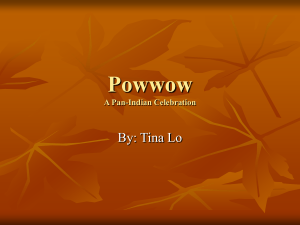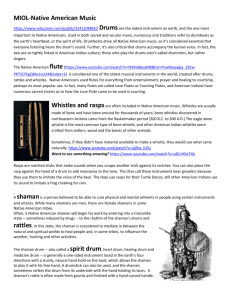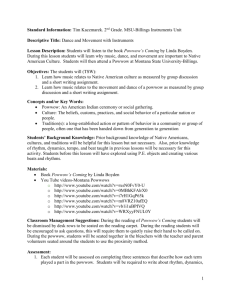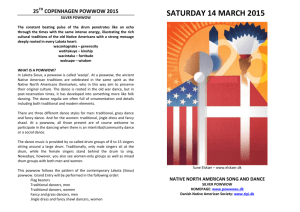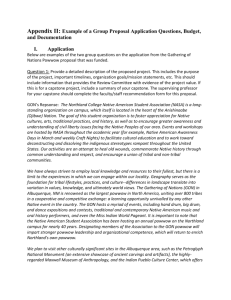Native Americans - lindseyrasmussen
advertisement
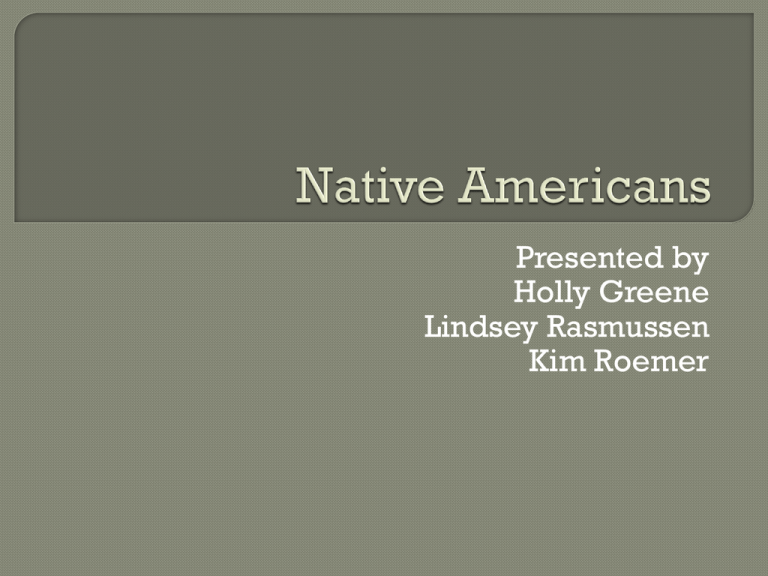
Presented by Holly Greene Lindsey Rasmussen Kim Roemer To give you a glimpse into what the Native American way of life was about, prior to the arrival European Americans. Some topics we will be presenting are: Spirituality, food, and survival. Some customs/traditions. We will conclude with counseling implications. There are multiple Native American tribes and although some were similar, others were vastly different. Some of the ceremonies, traditions, and ways of life varied from tribe to tribe. To be culturally competent you would want to learn the specifics of what is important and practiced by your client. FRUITS, NUTS, SEEDS, ETC. Goji berries Corn Saguaro cactus Barrel cactus fruit Red-seeded watermelons Wild walnuts, apples, and grapes Wild game and fish Domesticated beans Pemmican PEMMICAN Rawhide, which was strong and durable and was used to make shields, trunks, envelope like cases to carry things, moccasin soles, knife sheaths, snowshoes, bridles, stirrups, saddles, and saddlebags. Born on the Heider farm in Janesville Wisconsin in 1994 and died in 2004. In her lifetime she turned the 4 predicted colors of white, black, brown, and red. Floyd Hand, an elder of the Lakota predicted her birth. 1. 2. 3. Almost all Native American traditions stress the necessity of personally experiencing that which is sacred. This could be done by: Entheogenic substances such as Peyote. When used, had to be done so with great respect and sincerity. Seeking visions through fasting. Running long distances. This is a celebration of creation and life, when a young woman would reach puberty. Women are thought of as sacred because they have the ability to bring forth life. http://www.youtube. com/watch?v=WLiKv TQkc90 Focus is on healing the person (making him/her “whole”) instead of curing disease Based on belief that everything and everyone is interconnected and has a spirit or essence Illness stems from spiritual problems (i.e. person is unbalanced, has negative thinking, and/or lives an unhealthy lifestyle) Healing practices try to restore balance, More than 500 Native American Nations (or tribes) so healing practices vary considerably Information on healing practices general and limited because sacred traditions kept secret and passed from healer to healer Common rituals and practices • Herbal remedies • Purifying and cleansing body • Symbolic rituals Treatment a slow process Lakota Plains • Healers: Bear Dreamer Society; anyone cured became member • Leader: he who has bear dream and knows bear medicine Eastern Woodlands • Healer: medicine man • Used herbs not rituals Northwest Costal • Healer: shaman • Ritual: psychotherapeutic approach Southeastern/Cherokee • Healer: medicine man • Importance of “examining the beads” and proper formula for healing Navajo • Healer: shaman • Importance of corn pollen and corn meal Not proven to cure disease but reports suggest it can reduce pain, stress and improve quality of life Very few studies support validity of Native American healing because its based on spirituality Difficult to study because practices vary too much between tribes, healers, and illnesses Many Native Americans do not want practices studied because they believe sharing it exploits their culture and weakens their power to heal Dream are sacred and guidance given in dream message must be respected Dreams contain crucial information that defines one’s destiny, indicate route to be taken, and even cure disease Dream catchers originated with the Ojibwa (also known as the Chippewa) to protect children from nightmares How do dream catchers work? • Bad dreams are trapped in the web and good ones pass through to the sleeper • Or, web catches good dreams and lets the bad one pass through the hole Common practice among tribes in southwest because of summer droughts Ritual performed in mid to late August, driest month of the year Men and women wore special outfits and performed the dance together, in hopes it would bring desperately needed rain Many southwestern tribes still perform this ritual today Smudging has been used for centuries to create a cleansing smoke bath used to purify the body, aura, energy, space, or personal article Performed to remove negative energy and for centering/healing Sacred plants are burned, each with special powers: tobacco, sage, cedar, sweet grass, juniper, and lavender Plant(s) placed in shell/fireproof bowl, lit, and smoke wafted around oneself/environment with a feather, fan, or hand Do NOT blow smoke • Blows one’s negativity into the mixture • Blows away effectiveness of the plant(s) “Powwow” literally means “the one who has visions”; term also used to describe a meeting of different tribes or the title given to the shaman conducting the ceremony To understand significance of the powwow in today’s Native American culture, you must understand its origins • Believe when the world was created, each tribe given a unique relationship with the world and faith strengthened through connection with earth • In times of need/sickness, would turn to nature and hold meeting to pray, sing, and dance • Europeans assumed the term “powwow” referred only to the dance but was the word used to described the spiritual leaders conducting the ceremony • Powwows later used to resolve conflict and prepare/protect warriors Some traditional communities still practice powwows to honor their ancestors and preserve their heritage; often resemble powwows of the 1600s “Powwow” literally means “the one who has visions”; term also used to describe a meeting of different tribes or the title given to the shaman conducting the ceremony To understand significance of the powwow in today’s Native American culture, you must understand its origins • Believe when the world was created, each tribe given a unique relationship with the world and faith strengthened through connection with earth • In times of need/sickness, would turn to nature and hold meeting to pray, sing, and dance • Europeans assumed the term “powwow” referred only to the dance but was the word used to described the spiritual leaders conducting the ceremony • Powwows later used to resolve conflict and prepare/protect warriors Some traditional communities still practice powwows to honor their ancestors and preserve their heritage; often resemble powwows of the 1600s Pay attention and listen Never refer to a Native American dancer’s regalia as a costume Never touch a dancer’s regalia Never enter the Dance Arbor after it has been blessed Never record a Native American drum without permission Alcohol and/or drugs are not permitted at powwows Respect everyone, especially elders, and watch out for children Is there anything wrong with saying, “Some of my best friends are Indians?” Has alcohol always been apart of the Native American Culture? If not when do you think it became an epidemic? Do all Indians have a drinking problem? Is there a solution to substance abuse in Indian culture? What are the numbers exactly? American Cancer Society (2008). Native American healing. Retrieved from http://www.cancer.org. Butterfield, B. (2010). Rituals, beliefs, and customs of Native American culture. Retrieved from http://bonniebutterfield.com/indian-culture.htm. Native American powwow (2012). Retrieved from http://nativenet.org/na/native-american-powwow.html. Native American rain dance (2012). Retrieved from http://nativenet.org/na/native-american-rain-dance.html. Paper, J. (2007). Native north american religious traditions : dancing for life. West Port, CT: Praeger publishers. Pickering, R. B. (1997). Seeing the white buffalo. Boulder, CO: Johnson Printing. Schultz, B. (2011). Native American powwow etiquette. Retrieved from http://www.powwow-power.com/powwowetiquette.htm. Schultz, B. (2011). Smudging ceremony. Retrieved from http://www.powwow-power.com/smudging.html. Wolfe, D. (2009). Superfoods : The food and medicine of the future. Berkeley, CA: North Atlantic Books.

